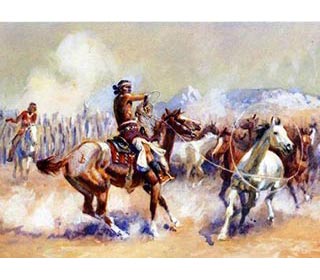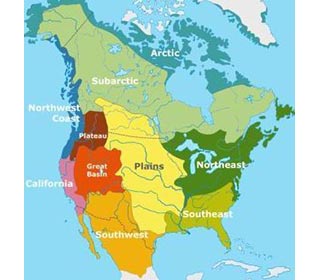What did the Navajo tribe live in?
The Navajo tribe lived in Earthen houses that were also called hogans, earth lodges or pit houses. Hogans were semi-subterranean dwellings that were dug from the earth. A wooden domed mound was built over the top that was covered with earth or reeds. What language did the Navajo tribe speak?
The Navajo tribe spoke in the Na-Dené Southern Athabaskan language known as Diné bizaad. What did the Navajo tribe eat?
The food that the Navajo tribe ate included deer, small game such as rabbit and fish. As farmers the Navajo tribe produced crops of corn, beans, squash and sunflower seeds. Their crops, meat and fish were supplemented by nuts, berries and fruit such as melon. As time passed the Navajo then started to raise sheep and goats with further supplemented their diet. What weapons did the Navajo use?
The weapons used were bows and arrows, stone ball clubs and knives. The rifle was added to their weapons with the advent of the white invaders. What clothes did the Navajo men wear?
The clothes worn by the Navajo tribe made good use of the natural resources that were available to them. The women spun and wove wool into cloth for ponchos, blankets and cloaks. Yucca fiber, from the Soaptree yucca, was also used to make sandals, belts and cloth and was also used to produce baskets and mats. Men's clothing included breechcloths which were made from a long rectangular piece of animal skin or cloth which was worn between the legs and tucked over a belt. Tunics with a concho belt fastened around the waist were also worn that were topped by cloaks or ponchos during the cold weather. They wore moccasins made of soft leather - a soft, light beige, slip-on shoe, consisting of a sole and sides made of one piece of leather. The traditional headdress worn by the Navajo men were simple cloth or leather headbands. What clothes did the Navajo women wear?
The type of clothes worn by the women. The women of the tribe wore clothes consisting of skirts and blouses. The skirts were traditionally made of woven yucca fiber. Like the men they wore blankets as cloaks for protection in cold weather. Hair was kept long and worn in a traditional hair knot called a Tsiiyeel which was wrapped in white yarn. Like all women they liked jewelry and wore turquoise and silver ornaments. What was the religion and beliefs of the Navajo tribe?
The religion and beliefs of the Navaho tribe was based on Animism that encompassed the spiritual or religious idea that the universe and all natural objects animals, plants, trees, rivers, mountains rocks etc have souls or spirits. The Navajo believes that the Yei Spirit mediates between humans and the Great Spirit and are believed to control elements such as the rain, snow, wind and sun and control the night and day. The two major ceremonial cycles have two branches: Beautyway and Evilway. The Beautyway is for celebration, strength and protection and the Evilway for healing. Important Navajo ceremonies include the Yeibichei dances and the Kinaalda for girls who have reached the age of puberty. Who were the most famous leaders and chiefs of the Navajo tribe?
The most famous leaders and chiefs of the Navajo tribe included Barboncito and Manuelito. Navajo History: What happened to the Navajo tribe?
The traditional enemies of the Navajo tribe included the Comanches, Apaches and the Utes. The Navajo joined forces with the Pueblo tribe and forced the Spaniards out of the area following the Pueblo Revolt of 1680. In the 1780s, the Spanish sent military expeditions against the Navajo. There were many conflicts between the Navajo and the US. Treaties were made and then broken. Colonel Kit Carson led an expedition into Navajo land and received their surrender on July 20, 1863. Starting in the spring of 1864 and ending in 1866 nearly 9,000 Navajo men, women and children were forced on the "Long Walk" of over 300 miles to the Bosque Redondo Reservation at Fort Sumner in New Mexico. In 1887 the Dawes General Allotment Act was passed by Congress which led to the break up of the large Indian Reservations and the sale of Indian lands, including Navajo lands to white settlers. | 
